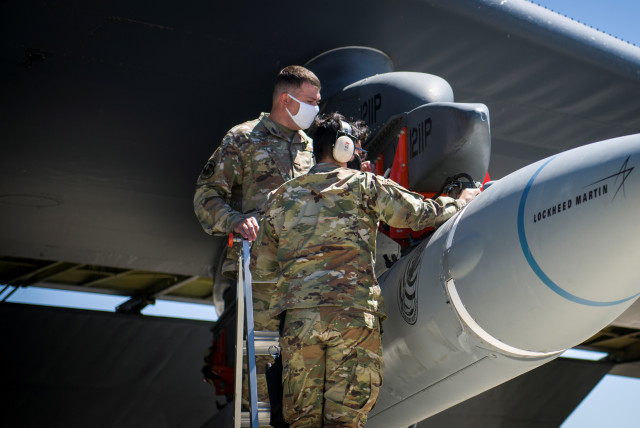US test of new hypersonic missile fails amid China, Russia pressure
With Russia, China and North Korea developing their own hypersonic missile capabilities, with some being able to carry nuclear warheads, the Pentagon is feeling the pressure.
A flight test of a new US hypersonic missile system in Hawaii, named “Conventional Prompt Strike,” failed, most likely due to a problem that took place after ignition, the US Department of Defense said in a statement.
“An anomaly occurred following ignition of the test asset,” Pentagon spokesman Navy Lieutenant Commander Tim Gorman said. “the Department remains confident that it is on track to field offensive and defensive hypersonic capabilities on target dates beginning in the early 2020s.”
“Program officials have initiated a review to determine the cause to inform future tests,” he said. “While the Department was unable to collect data on the entirety of the planned flight profile, the information gathered from this event will provide vital insights.”
“While the Department was unable to collect data on the entirety of the planned flight profile, the information gathered from this event will provide vital insights.”Pentagon spokesman Navy Lieutenant Commander Tim Gorman
The recent failure marks the second unsuccessful test flight of the prototype weapon, in October 2021, a booster malfunction, which prevented the missile from leaving the launch pad, rendered the weapon system’s first test flight a failure as well.
The Conventional Prompt Strike weapon system is expected to be installed on Zumwalt destroyers and Virginia-class submarines.
With Russia, China and North Korea developing their own hypersonic missile capabilities, with some being able to carry nuclear warheads, the Pentagon is feeling pressure to deploy the newly developed weapon system as soon as possible.
China
The Chinese military believes hypersonic weapons will change the nature of the battle and is investing heavily to advance their capabilities.
“China tested a nuclear-capable hypersonic missile in August that circled the globe before speeding towards its target, demonstrating an advanced space capability that caught US intelligence by surprise,” according to the Financial Times.
China has been working on these missiles for decades, according to the US Defense Intelligence Agency’s 2019 China Military Power Report, the Chinese People’s Liberation Army (PLA) “is developing a range of technologies to counter US and other countries’ ballistic missile defense systems, including maneuverable reentry vehicles (MARVs), MIRVs [multiple independently targetable reentry vehicles], decoys, chaff, jamming, thermal shielding, and hypersonic glide vehicles.”
On 1 October 2019, the 70th anniversary of the establishment of the People’s Republic of China, in a parade that reviewed the PLA’s troops and weapon systems, the PLA revealed a new hypersonic missile, the Dong Feng (DF) 17.
A PRC blog devoted to military affairs described the DF-17 as a “combat-ready hypersonic weapon.”
China is investing heavily in heat-seeking hypersonic weapons, claiming that they “will be able to hit a moving car at five times the speed of sound,” with a new system that is set to deploy by 2025, according to scientists involved in the project.
The research team, led by Yang Xiaogang from the PLA Rocket Force University of Engineering in Xian, said “important progress” had been made towards solving the main problem of how to pinpoint a moving target at extreme speeds.
Yang and his colleagues from the university’s College of Missile Engineering have been given a deadline of 2025 to come up with solutions to the seemingly intractable challenges of hypersonic technology.
Over distance, the infrared signature of a small moving target “constitutes just a few pixels without detailed information such as shape, texture and structure,” making identification and tracking “extremely difficult”, they explained in a paper published in the Chinese peer-reviewed journal Infrared and Laser Engineering.
The hypersonic heat-seeker would also be able to go after a target in the air, according to a separate paper in the series by Qin Hanlin from the school of optoelectronic engineering at Xidian University.
Qin and his team demonstrated a technology that would allow a hypersonic ground-to-air missile to hit a target as small as a commercial drone. The missile could identify the drone hanging low over buildings or trees with nearly 90 percent accuracy, they said.
The PLA’s hypersonic program employs about 3,000 scientists, 50 percent more than those working on traditional weapons, according to a study published in January by the Chinese peer-reviewed journal Tactical Missile Technology.
Russia
In March 2022, the Russian navy conducted a test of a prospective hypersonic missile, the ‘Zircon,’ in a demonstration of the military’s long-range strike capability amid the fighting in Ukraine.
The Admiral Gorshkov frigate of the Northern Fleet in the White Sea launched the Zircon cruise missile in the Barents Sea, successfully hitting a practice target in the White Sea about 1,000 kilometers away, according to Russia’s Defense Ministry.
The launch was the latest in a series of tests of Zircon, which is set to enter service later this year, according to Russian sources.
Zircon is intended to arm Russian cruisers, frigates and submarines and could be used against both enemy ships and ground targets. It is one of several hypersonic missiles under development in Russia.
Russian officials have boasted about Zircon’s capability, claiming that it’s impossible to intercept with existing anti-missile systems.
Earlier, in 2018, a demonstration of the ‘Avangard’ hypersonic missile proved successful, according to the Russian Defence Ministry.
After separating from its carrier in the stratosphere, the HGV maneuvered 6000 kilometers across Siberia at a searing Mach 27, according to Russian officials, then hit a target on the Kamchatka Peninsula.
Russian President Vladimir Putin called Avangard “the perfect New Year’s gift for the country.” Russia’s Defence Ministry claimed that it has put the nuclear-armed HGV into combat duty in 2020, allowing Putin to claimthat Russia was the first country armed with functional hypersonic weapons.

No comments:
Post a Comment